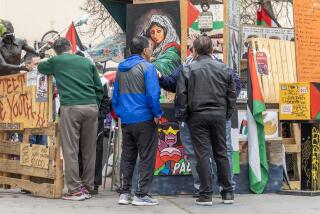Time Shrinks Size of Crowd, Not Impact of 1847 Treaty
- Share via
Members of the Campo de Cahuenga Assn., their ranks depleted by the passing of time, gathered Sunday for the 35th consecutive year to commemorate the signing of a treaty between Mexico and the United States that eventually led to statehood for California.
“I thought there would be more here,” said George Shipley, the 75-year-old president of the association that sponsors the event. “At one time, we had as many as 450 people attend this program.”
But on this day, an estimated 150 mostly elderly men and women, many dressed in their Sunday best, listened to entertainment that featured Indian dancers and singing and yodeling by cowboy actor Chuck Ryan, 71, who once made movies with old-time cowboy star Hoot Gibson.
Historian Louis Fisch, the day’s featured speaker, told the audience that Campo de Cahuenga played a special role in American history.
‘Jewel of California History’
The crowd applauded when Fisch called the one-story adobe building, at 3919 Cahuenga Blvd. in North Hollywood, the “birthplace of California” and “a jewel of California history.”
It was on that site on Jan. 13, 1847, Fisch said, that Gen. Andres Pico, commander of Mexican forces in California, and Lt. Col. John C. Fremont, commander of the California Volunteer Battalions, drafted and signed the Treaty of Cahuenga, in which Mexico turned over California, Nevada, Utah, Arizona and parts of New Mexico, Oklahoma and Wyoming to the United States.
“With a few strokes of a pen, the United States gained a mighty empire comparable almost to the Louisiana Purchase,” Fisch said.
“This is the most important historical site in Western America,” said master of ceremonies Lawrence Young, one of the few remaining members of the Campo de Cahuenga Assn. “All of western America belongs to the United States because of what happened at this site.”
No matter how important a part Campo de Cahuenga played in California history, the landmark has not gained the widespread recognition it deserves, Shipley, Fisch and Young agreed.
Fisch said the landmark, which originally was the residence of Jose Vincente Feliz, was forgotten after the treaty was signed. By 1900, the neglected building had disintegrated and disappeared. The site’s rediscovery, based on recollections by Fremont, was followed by a long period of patient efforts to stimulate public interest in the its past, Fisch said.
Finally, the late Mrs. Armitage S. C. Forbes founded the association and convinced the Los Angeles City Council to buy the site, which was being used as a small animal hospital.
In 1924, it was dedicated as Fremont-Pico Memorial Park. A few public improvements were made but apathy set in again and the site soon was overgrown with wild shrubbery. Shipley said the Campo de Cahuenga Assn. gathered 32,000 signatures on a petition and drew up plans for reconstruction of the Feliz Adobe.
As a result, the current Campo de Cahuenga, which is operated as a museum and meeting place by the Los Angeles Recreation and Parks Department, was dedicated on Nov. 2, 1950.
Public interest appears to be waning once again, however. At one time, Shipley said, the association, using volunteer guides, opened the landmark to the public on Sundays. But money ran out in the city’s budget and it could not afford to pay a staff member to be present during the volunteer effort. Shipley, president of the association for 20 years, said the group also used to hold art shows at the monument.
“We wanted to open it to students for their history projects,” he said.
But Shipley said the only activity the association now sponsors on a regular basis is the annual observance of the treaty signing.
Dwindling membership in the association is largely responsible for any lack of public interest in Campo de Cahuenga, Shipley said.
“Most of the members have passed away,” he said. “We have only about five active members now.
“I’m trying to get some new blood into the group,” Shipley said. “People are taking more of an interest in history now. We’re trying harder to get the word out.”
More to Read
Sign up for Essential California
The most important California stories and recommendations in your inbox every morning.
You may occasionally receive promotional content from the Los Angeles Times.













